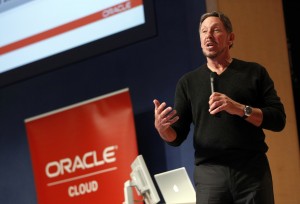Rumour has it that Oracle CEO Larry Ellison will introduce a next-generation version of the Exadata database machine, the first and apparently most successful of its “engineered systems” that combine Oracle software with servers, networking and storage, at the OpenWorld conference next week.
Oracle’s flagship conference kicks off Sunday with a keynote from Ellison, and contrary to prior years, this time Oracle has told the public a bit of what plans to say.
Titled “Hardware and Software, Engineered to Work Together: Why It’s A Different Approach,” Ellison’s talk will cover Oracle’s “fundamentally different approach to delivering technology that is engineered to work together,” according to the description, which sounds much like the marketing lines the company has long used to pitch Exadata and other systems.
It would also make sense for Ellison to unveil a next-generation Exadata given that he has recently revealed Oracle will announce version 12c of its flagship database, which powers Exadata, at OpenWorld.
But the most concrete public evidence that a new Exadata is coming soon may be found in an alert to Oracle partners that has been posted on the vendor’s website. The alert states that Exadata version X2-2, one of the current editions, is “end of life” with the “last order date” being Sept. 3.
Oracle senior vice president Juan Loaiza is also scheduled to deliver a presentation on “where Exadata is going in the future” during OpenWorld.
An Oracle spokeswoman declined a request for comment on Oracle’s Exadata plans.
Still, some industry observers have already begun speculating and piecing together clues about what upgraded machines will include.
Oracle database administrator Andy Colvin recently posted an image of a Web page inside Oracle’s My Oracle Support portal that shows knowledge article listings referring to Exadata X-3 hardware in various configurations, including an “eighth rack” option.
“Seeing an eighth rack Exadata could be interesting — possibly along the lines of the seldom-seen Exadata V2 basic system (One compute node, one storage server, one Infiniband switch),” Colvin wrote. “This would be a big sell for customers that want to give Exadata a try, or very small dev/test systems. Keep in mind that there isn’t much redundancy in these systems, and the performance isn’t quite as great as you’d see on a quarter rack.”
Details of Oracle’s plans for the specialised software that runs on Exadata along with Oracle’s database have also surfaced. One attendee of a speech given last month by Oracle database chief Andy Mendelsohn grabbed a snapshot of a slide displayed during the talk.
Upcoming features include “in-memory optimised compression,” “memory-to-memory Infiniband messaging” and “Flash for all writes,” according to the slide. It wasn’t clear whether any of the features mentioned are imminent or just part of a long-term plan.
A new Exadata product won’t be huge news if it just seems to be a bigger, faster version of the current editions, according to Eric Guyer, a consultant who advises Oracle customers on dealings with the vendor and author of the Oracle Optimisation blog.
“The Exadata of today is in my opinion, RAC on steroids,” Guyer said in an interview Tuesday, referring to Oracle’s Real Application Clusters software. “Exadata has not been a great destination for consolidating dozens and dozens of database workloads because it doesn’t have good virtualisation.”
“I would like to see an Exadata version that is capable of things like Solaris containers,” allowing customers to run older database versions on Exadata, Guyer added. “Right now it’s [database] 11g R2 only with no virtualisation. That to me is where they need to go. They’ve got to make it so customers can slice and dice [Exadata’s capacity] better. If the next version is just bigger, faster, stronger, it’s kind of a non-announcement to me.”
The smart money may be on a fairly splashy Exadata reveal from Oracle, either as part of an actual product launch or a statement of future direction.
That’s because Oracle needs to raise customer interest in the “engineered systems” notion, upon which it is staking the hardware business acquired through the purchase of Sun Microsystems, rather than compete in the commodity server market.
Hardware revenues in Oracle’s first quarter dropped 24 percent to $779 million, repeating a pattern of decline since the Sun deal closed. While Oracle has emphasised that Exadata, Exalogic and its other appliances are much more profitable than commodity servers, investors may soon become restless for the company to show top-line revenue growth in hardware.






